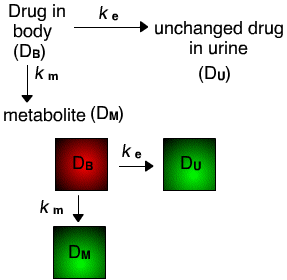Pharmacokinetics of Drug Eliminated by Simultaneous Metabolism and Excretion
Most often, drugs are eliminated from the body by two means. First, drug is excreted via urine and another is by being metabolically altered by the body. Both forms of elimination however, often follow a first order process with the rate of excretion and metabolism dependent on the amount of unchanged drug in the body. Here we see a pharmacokinetic model depicting the elimination of drug.

The elimination rate of the drug from the body is determined by both ke and km, and is written as:
(1)

Thus, the final elimination rate constant (kel) is the sum of the urinary excretion rate constant (ke) and the metabolism rate constant (km).
(2) kel = ke + km
For drugs that are both metabolized and unchanged when excreted, the semilogarithmic plots between their plasma concentrations and time have slopes equaling -kel/2.3. Individual values of ke and km are determined by urine data. It can be shown that:
(3)

(DU(infinity) - DU(t)) is the amount remaining to be excreted (ARE). The equation shows that a graph between ARE vs. time would yield a slope equalling -kel/2.30 even if the drug is partially eliminated by metabolism. Using (DU(infinity)/DB0 = ke/kel), we can figure out ke and from equation (2) calculate km.
B.7a-1